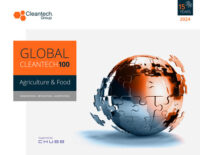Agriculture & Food Key Takeaways – Cleantech Forum Asia
At Cleantech Forum Asia we highlighted Agriculture & Food in two key sessions on our agenda.
In the first session we looked at the alternative protein industry under the title ‘Will Asia Lead the World in Alternative Protein Production in the Next 5 Years?’. For this session we welcomed:
- Mirte Gosker, Acting Managing Director, Good Food Institute
- Carrie Chan, CEO, Avant Meats
- Sumit Pingle, Vice President; Agro & Protein Systems, Alfa Laval
- Saurabh Bajaj, CEO – Asia, Eat Just
There are two key trends in alternative protein product development in Asia:
- The localization of products to suit local cuisines and tastes.
- The diversification of raw ingredients for plant-based meat products.
60% of all seafood consumed is eaten in Asia, and so developers based there are more focused on seafood replacements.
The path to scale is quite different for plant-based and cultivated meats. For plant-based options, one of the key issues is choosing your primary feedstock and working out where you want to sit on the quality-yield spectrum. There are incumbent industry partners who can help companies reach scale and help with each step of the scale-up process. For cultivated proteins, the process itself is a key part of what companies are working on. This makes finding expertise critical to success, as well as finding friendly regulatory systems to support the scaling of a new production method. Singapore’s regulatory approval for Eat Just’s cultured product is the first of its type in the world and clear signal for developers working on this product globally to look to Asia.
A key barrier to growth in plant-based foods is the availability of key infrastructure such as wet extrusion. While the panel agreed on this point, it was also noted this was true globally, and there were no more significant barriers to increasing production capacity in Asia Pacific compared to other regions.
One of the key drivers to reduce the production cost for cultivated meat has been the replacement of fetal bovine serum. This has achieved a 50%-80% reduction in cost. In the future, alongside the incremental improvement of production processes, alternative proteins will find cost savings in the last mile as new manufacturing technologies increasingly allow for distributed manufacture.
Will You Join Us At The Next Forum?
Indoor Farming
In another session, we focused on indoor farming under the title ‘Indoor farming: Crop Diversity, Scale, and Profitability’. For this session we welcomed:
- Ben Swan, CEO & Co-Founder, Sustenir
- Stuart Oda, CEO & Founder, Alesca Life
- Francisco Kweon, CEO, Griin Agriculture
- Justin Lee, Associate Director, TRIREC
Indoor farming is critical for food security. In the past to ensure food security you just needed to align with a strong agricultural neighbor to secure food supply. In an increasingly resource constrained world, and especially during periods when borders are closed, securing food supply is critical. This is true in dense cities of Asia, giving rise to a large market for indoor farming technology.
Conventional farming creates waste, cuts down trees to make room for more farming and has created very high emissions transportation infrastructure. Indoor farming does not need to compete with all conventional production, it just needs to compete with the imports.
Scaling in Asia is different to other regions (North America and Europe particularly) because:
- Their target addressable market is different and larger
- Land value is often high and there are few brownfield sites to locate your farm when working in Asian cities
- Scaling across countries presents regulatory challenges that do not exist when scaling from West to East Coast in the US, or even throughout Europe.
Business models vary. From a producer looking to use the best tool available to grow high quality produce at low cost (Griin) to a technology developer such as Alesca Life which doesn’t want the acquisition of local market knowledge to be a barrier to scale. Whereas vertically integrated Sustenir are taking on the end to end of the value chain, and are eyeing up high value ingredients such as TCM/Pharma/Cosmetics.
The hardware stack you develop depends on local market conditions. For example, operating in Singapore where wages are high will encourage the use of automation. Operating in China or other developing economies will have technology more focused on energy savings, consistency of operations, and other guard rails to ensure optimum operation.
Indoor farming in Asia is a B2G market. Policy needs to be supportive in order to reach scale. There are over 800 smart cities being developed in China alone, each engaging with new technologies to build sustainable cities.
Crop diversity is critical to the success of indoor farms, and you can only grow diverse produce if you have a flexible growing system. The flexibility an indoor farm offers means growers can react quickly to customer preferences and changes, as well as optimize growing conditions according to taste. You can grow high value products out of season, offering better margins on like-for-like produce compared with conventional growers.
Keep an Eye On….
In alternative proteins, keep an eye on hybrid products that use both cultivated meat and some plant protein to take functional and cost benefits from both to make a superior product. As mentioned above, keep an eye on distributed manufacturing systems for proteins that leverage low logistics costs and small-scale production facilities.
In indoor farming, keep an eye on more SPAC announcements after Aerofarms as companies look for new ways to raise capital to expand footprint. Also keep an eye on genetic and seed breeding technologies focusing on new crop varieties, signaled by the Bayer and Temasek founding of Unfold in 2020.



